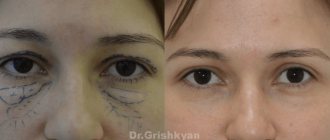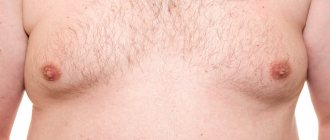Subjective first signs of pregnancy
Often the first changes in the body that a woman differentiates as signs of pregnancy may turn out to be symptoms of PMS. However, if you have never suffered from premenstrual syndrome before, you should pay attention to these:
- Feeling of weakness, malaise and increased fatigue even with usual exercise.
- The appearance of drowsiness during the day and insomnia at night.
- Unstable emotional state. A woman’s mood can change dramatically in a matter of seconds without good reason.
- A feeling of heaviness in the lower abdomen, lower back and pelvic area.
- Constant headache and dizziness.
- Change in libido. Moreover, it can either decrease or increase.
- Periodic sensations of heat or chills that replace each other.
- Increased sensitivity of the mammary glands to the point that any touch to the breast results in extremely unpleasant sensations and even pain.
- Increased appetite or change in eating habits. From the first days of pregnancy, a girl may want to eat more or eat dishes that she did not like before.
- The appearance of an unreasonable feeling of nausea. In some cases, heartburn and vomiting occur. This condition is called toxicosis.
- Increased sensitivity to odors and distortion of the sense of smell.
All of the above signs cannot accurately answer the question: has pregnancy occurred or not? However, they allow us to suspect it and move on to more accurate and reliable diagnostic methods.
Correct effective breastfeeding
A good attachment to the breast and effective sucking by the baby is observed with the following signs:
- Most of the areola, including the nipple, is in the baby's mouth.
- The breast is pulled into the mouth, forming a long "nipple", but the nipple itself takes up about a third of the space in the mouth. The areola is almost invisible.
- The baby sucks on the breast, not the nipple. His mouth is wide open, his chin is pressed to his mother's chest, his lips are turned outward, his head is slightly thrown back.
- The baby's tongue is directed forward towards the lower gum, folded at the edges to form a bed for the nipple. When a baby suckles, a wave travels along the tongue from front to back, pressing the nipple and part of the breast against the hard palate to squeeze milk from the breast into the mouth for swallowing.
- The baby actually uses suction mainly to draw breast tissue into the mouth and hold it there.
- When the baby is well attached and properly attached to the breast, his mouth and tongue do not rub or injure the skin of the nipple and areola.
- The baby is comfortable, and the feeding process is pleasant for the mother. She doesn't feel pain.
If the baby is well attached to the breast, then he will be able to suck milk effectively. The following signs will indicate this: the baby makes slow, visible sucking movements. Swallowing sounds are heard approximately once per second. Sometimes the baby pauses for a few seconds, allowing the milk to fill his mouth. When the baby starts sucking again, he can do it a little faster at first, stimulating the supply of milk, and then switching to slow, deep sucking movements. The baby's cheeks remain rounded during feeding. Toward the end of feeding, sucking usually slows down, movements become less frequent and are accompanied by longer pauses. It is important that the baby continues to suckle, since at this time the “hind” milk, rich in fats, arrives. When the baby is full, he spontaneously releases the breast. The nipple may look stretched at this time, but it returns to its original shape in a few seconds.
External changes during the first days of pregnancy
Also, in addition to the symptoms indicated in the previous section of the article, which the woman notes herself, certain external changes occur that are noticeable to the people around her.
Due to hormonal changes, skin problems may appear. Many girls who have not previously suffered from acne notice that rashes begin to appear.
Swelling of the face, arms and legs also accompanies pregnancy, including in the early stages. Sometimes their severity reaches such an extent that the girl cannot walk in her usual shoes.
Breasts can increase by 1-2 sizes already in the first weeks of pregnancy. At the same time, the appearance of a venous vascular pattern and darkening of the nipple areola are noted.
The pigmentation of the midline of the abdomen, running from the navel to the pubis, also increases. This symptom is observed in most pregnant women.
A blush often appears on the skin of the face. This sign is explained by increased blood flow in the body of the expectant mother.
Vitamins for tooth enamel
Calcium is the main element of the skeletal system. However, the body does not fully absorb it: it is necessary to supplement calcium with vitamins D and E.
| Vitamin | Purpose | Products |
| Vitamin D | From increased sensitivity of enamel. | Fatty fish (salmon, trout, mackerel), cod liver oil, beef liver, dairy products (especially butter), egg yolk, mushrooms, sunflower seeds. |
| Vitamin E | For nutrition of dental tissues and resistance of mucous membranes to bacteria. | Sunflower seeds, soybean oil, almonds, grains and legumes, walnuts, green leafy vegetables. |
Clinical symptoms at the beginning of pregnancy
Already in the first few days after conception, the following conditions and changes in the body of a pregnant girl may develop:
- Early factor. This is the name of a special substance that is released 1-2 days after fertilization. According to the data obtained, it is found in 67% of examined women whose pregnancy was subsequently confirmed.
- Bloody discharge from the genital tract. They may have a yellowish or pinkish tint and appear when the fertilized egg attaches to the uterine walls. This usually happens at the end of the first, beginning of the second week after conception.
- The increase in basal temperature that appeared at the time of ovulation persists for a long time if fertilization has occurred. Its measurement can indirectly confirm the occurrence of pregnancy. The general body temperature may also rise to 37 degrees.
- Paresthesia, pain and cramps in the calf muscles. As a rule, they occur late in the evening or at night, causing sleep disturbances and even insomnia.
- A decrease in blood pressure, which is manifested by severe weakness and dizziness. With significant hypotension, fainting is possible. The risk of developing this condition is prolonged exposure to a stuffy, unventilated room or standing position.
- Decreased immunity. Manifested by frequent colds. Also, against the background of immunodeficiency, pregnant women may be bothered by genital candidiasis or, in other words, thrush.
- Increased urge to urinate. Most often this symptom appears in later stages of pregnancy, but it can also occur in the first days.
Despite the huge number of signs, most often a woman pays attention to a delay in menstruation. And for good reason. This is the most obvious and accurate symptom that should lead you to certain thoughts. Of course, menstrual irregularities occur in a huge number of pathological conditions. However, if you are planning a pregnancy, a delay may be the first bell indicating the onset of the long-awaited conception.
Immediately after the onset of the above sign, you can conduct a test that is sensitive to an increase in hCG.
How to strengthen tooth enamel
Fluoridation
Fluoridation is the most common and only proven effective way to strengthen enamel. It involves applying fluoride-containing compounds to the surface of the teeth.
Penetrating into tooth enamel, fluoride accelerates the absorption of calcium and phosphorus, strengthening and restoring the tooth surface.
It happens like this: fluorine molecules combine with hydroxyapatite, forming hydroxyfluorapatite, a mineral that is resistant to acids. Learn more about the benefits of fluoride
For home care and caries prevention, you can use fluoride toothpastes. The most effective are those containing sodium fluoride and amino fluorides. The higher the fluoride content, the stronger the remineralizing property of the paste and the protection against caries.
The fluoride concentration in toothpaste is measured in ppm or percentage. If the tube says that it contains 900 ppm fluoride, then a kilogram of paste will contain 900 mg of this element.
| Type of pasta | Purpose | Fluoride amount |
| Preventative | For daily use. | up to 1000 ppm |
| Medical | Intensive strengthening of enamel at the first signs of caries. The time of use is limited by the course prescribed by the doctor. | 1000-1500 ppm |
Toothpastes with fluoride
Toothpaste CURAPROX Enzycal 1450
ApaCare Remineralizing Toothpaste
Colgate Elmex Toothpaste Caries Protection
Elgidium toothpaste Protection against caries
Nanohydroxyapatite
Medical nanohydroxyapatite is no different in composition from natural one. Thanks to this, it is easily integrated into the crystal lattice of enamel and solves the following problems.
- Seals microcracks.
- Reduces tooth sensitivity.
- Eliminates caries at the white spot stage.
Toothpastes with hydroxyapatite
Biorepair Total Protection toothpaste 75 ml
miradent mirasensitive hap+ toothpaste for sensitive teeth
Vivax toothpaste. Remineralization.
Dentissimo Complete care toothpaste Complete care
Amorphous calcium phosphate
When in contact with saliva and hydroxyapatite, this element forms a special biofilm on the surface of the teeth, which:
- protects enamel from the harmful effects of acids;
- ensures the connection of bioavailable calcium with enamel, accelerating its remineralization.
Important! Since the active substance is obtained from cow's milk casein, this method of strengthening enamel is not suitable for people with allergies to milk protein.
Gels and toothpastes with amorphous calcium phosphate
Tooth gel GC MI Paste Plus Mint
Tooth gel GC Tooth Mousse Strawberry
Toothpaste Apagard Premio 100 ml
Theobromine
This is the youngest, most innovative way to strengthen enamel using cocoa bean extract. Theobromine stimulates the formation of its own hydroxyapatite crystals in the enamel. Theobromine pastes are produced by Theodent brand.
The remedies listed above can be used at home to prevent and treat minor oral problems.










